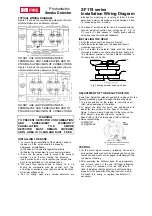
INTRODUCTION TO THE INTRINSICALLY SAFE FIRE DETECTION DEVICE
This wireless smoke detector has been certified by Baseefa and has been awarded the ATEX Classification
II 1 G ; Ex ia op is IIC T5
Ga –10˚C ≤ Ta ≤ +55˚C
making it suitable for Category 1, 2 or 3 hazardous atmospheres with a maximum ambient temperature up to 55˚C.
The product has been assessed and certified for ATEX & IECEx requirements for hazardous applications according to the following standards:
IEC 60079
-
0:2011 / EN 60079
-
0:2012+A11:2013
IEC 60079
-
11:2011 / EN 60079
-
11:2012
IEC 60079
-
28:2015 / EN 60079
-
28:2015
It is recommended
that installation only be carried out by qualified personnel according to hazardous
area safe working practice and in conformity to the terms of the product certifica-
tion. Note that the Translator Interface to which this device will be linked does not
form part of the ATEX/IECEx certified system and must be sited in the safe area
which is not subject to hazardous conditions.
GENERAL DESCRIPTION
The intrinsically safe wireless optical smoke detector samples the air to deter-
mine an alarm conditions in the protected environment. Its design and construc-
tion makes it suitable for installation in hazardous environment according to ATEX
DIRECTIVE 2014/34/EU. System design should follow National Regulations or
Codes of Practice including reference to standards related to hazardous areas
(e.g. EN 60079
-
14:2014) as appropriate.
These detection devices are designed for indoor applications and care should be
taken to ensure the environmental conditions are suited to the device type so that
unwanted alarm conditions are prevented.
DETECTOR VISUAL LED INDICATOR
The wireless optical smoke detector is equipped with a LED that provides visual
indication for functional modes, battery faults and other fault types (see table 1).
LINKING THE DEVICE TO THE SYSTEM
This detector must be
linked to the fire detec-
tion
system
before
installation; specifically it
must be linked to its
translator or expander
interface following the system design plan.
NOTE: As a safety precaution linking and power up of devices should
be carried out adjacent to the translator/expander interface in the safe
area.
For more detailed information about wireless linking refer to “Guide to
wireless system installation” document (APN
-
W0001) or refer to your system
supplier.
This manual gives the specific linking procedure applicable only to this detector.
SG100
-
IS
INTRINSICALLY SAFE WIRELESS
OPTICAL SMOKE DETECTOR
ARGUS SECURITY S.R.L.
-
Via del Canneto, 14
-
34015
-
Muggia (TS)
-
Italy
www.argussecurity.it
1. Detector
2. Mounting base
3. Visual LED indicator
4. Link switch
5. Tamper switch
6. Batteries housing
7. Secondary battery
8. Main battery
9. Battery cover
Picture 1
Picture 2
Extract the isolating tab from
the back of the detector
Table 1
LED SIGNAL MEANING
LED VISUAL SIGNAL
“
Power up mode
”.
The isolating tab has just been
extracted or the main battery
has just been inserted.
Green
LED blinks;
Orange
LED on for 2 seconds;
Red
LED blinks.
“
Linking mode
”.
Linking phase has been
started.
Green
LED blinks;
Red
LED blinking 1 second on
and 0.1 second off;
Green
and
red
LED alternat-
ing for 1 second.
“
Linking failure mode
”.
Red
LED continuously on.
“
Normal operating mode
”.
LED off.
“
Alarm mode
”.
Red
LED blinking: 0.5 second
on and 0.5 second off.
Device unpowered.
LED off.
Main battery fault (low charge)
Orange
blinking: 0.1 second
on and 5 seconds off.
Secondary battery fault (low
charge)
Green
LED blinking: 0.1
second on and 5 seconds off.
Both batteries fault
Sequential
orange
-
green
LED
blinking: 0.1 second on and 5
seconds off.
Tamper fault
LED off.
Other fault type
Sequential
orange
-
green
LED
blinking: 0.5 second each
colour.
Baseefa16ATEX0111X
IECEx BAS 16.0050X






















